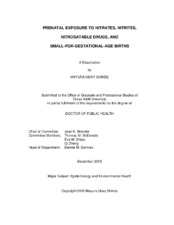| dc.contributor.advisor | Brender, Jean D | |
| dc.creator | Shinde, Mayura | |
| dc.date.accessioned | 2014-05-13T17:31:55Z | |
| dc.date.available | 2015-12-01T06:31:20Z | |
| dc.date.created | 2013-12 | |
| dc.date.issued | 2013-11-27 | |
| dc.date.submitted | December 2013 | |
| dc.identifier.uri | https://hdl.handle.net/1969.1/151967 | |
| dc.description.abstract | Certain drugs, which contain nitrosatable amines (secondary or tertiary amines) or amides can react with nitrite in the stomach to form N-nitroso compounds. Experimental data from animal studies suggest that exposure to these compounds might reduce fetal birthweight. We examined the relation between prenatal exposure to drugs classified as nitrosatable and dietary intake of nitrates/nitrites and small-for-gestational (SGA) births. Data were analyzed from the National Birth Defects Prevention Study (NBDPS) control participants (mothers of babies without major birth defects), that included 526 mothers who delivered infants with birthweight <10^(th) percentile and 5970 mothers of control infants (birthweight ≥10^(th) percentile for gestational age) during 1997-2005. Information was collected by telephone interview on type and frequency of medication use, diet, supplementation, demographic characteristics, and maternal health. Overall, prenatal use of nitrosatable drugs was not associated with SGA except for a few notable exceptions. Relative to women who reported no nitrosatable drug use anytime during pregnancy, women who took nitrosatable amides during the third trimester of pregnancy were more likely to have SGA births (adjusted odds ratio [OR] 1.4 [95% confidence interval [CI] 1.0, 2.1]). This association was stronger among full term SGA births (OR 1.6 [95% CI 1.1, 2.3]). Dietary nitrites modified the associations between nitrosatable drugs and SGA but lower odds of SGA were observed among women with higher nitrite intake. Higher intake of dietary vitamin C (≥85 mg/day) in combination with daily vitamin C supplementation reduced the associations between SGA and secondary amine use during the second trimester of pregnancy (aOR 1.0 [95% CI 0.65, 1.6]) compared with <85mg of dietary vitamin C and less than daily use of vitamin C supplement (OR 4.0 [95% CI 1.5, 10.9]). Prenatal exposure to nitrosatable drugs and higher intake of dietary nitrites did not appear to be associated with SGA. Supplemental and dietary vitamin C may modify the risk of SGA birth in relation to nitrosatable drug use during pregnancy. | en |
| dc.format.mimetype | application/pdf | |
| dc.language.iso | en | |
| dc.subject | nitrates | en |
| dc.subject | nitrosatable drugs | en |
| dc.subject | small for gestational age | en |
| dc.title | Prenatal Exposure to Nitrates, Nitrites, Nitrosatable Drugs, and Small-For-Gestational-Age Births | en |
| dc.type | Thesis | en |
| thesis.degree.department | Epidemiology | en |
| thesis.degree.discipline | Epidemiology and Environmental Health | en |
| thesis.degree.grantor | Texas A & M University | en |
| thesis.degree.name | Doctor of Public Health | en |
| thesis.degree.level | Doctoral | en |
| dc.contributor.committeeMember | McDonald, Thomas M | |
| dc.contributor.committeeMember | Shipp, Eva M | |
| dc.contributor.committeeMember | Zheng, Qi | |
| dc.type.material | text | en |
| dc.date.updated | 2014-05-13T17:31:55Z | |
| local.embargo.terms | 2015-12-01 | |


